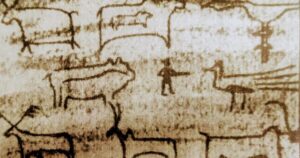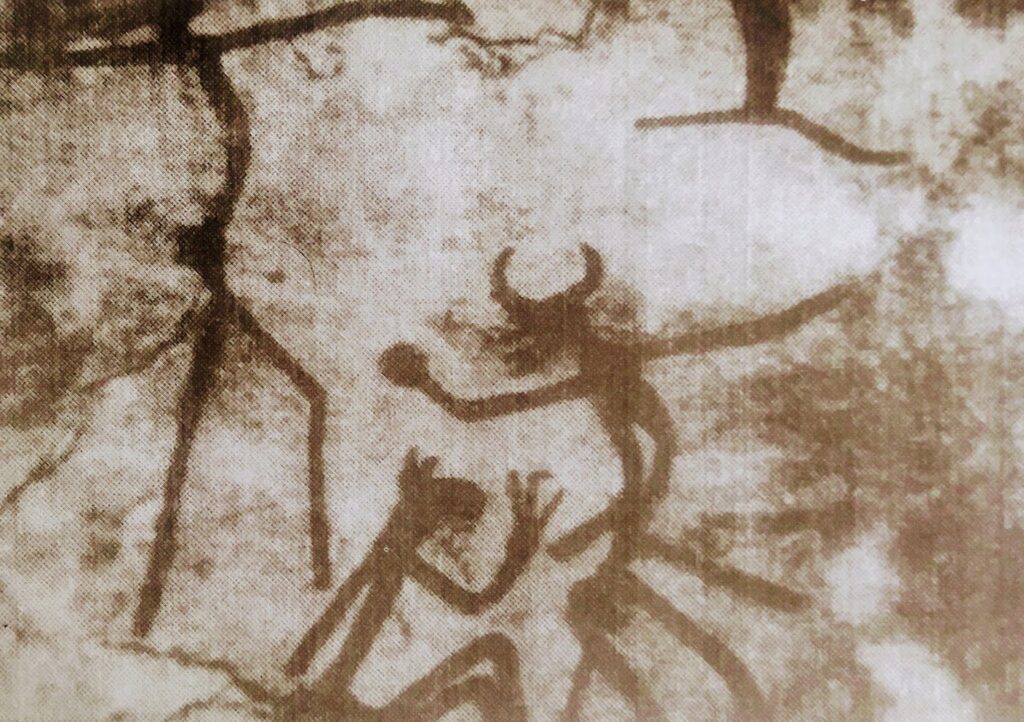
Roaring Animal
WIZARD’S DANCE
 NAME: WIZARD’S DANCE
NAME: WIZARD’S DANCEMEDIUM: MINERAL COLOR STONE
PERIOD: 2500 B.C. TO 1500 B.C. (Stone age)
LOCATION: BHIM BETHAKA CAVE 50Km SOUTH OF BHOPAL (M.P)
SUBJECT MATTER / THEME: A ceremonial dance of the wizard’s like cave men to depict some joyful celebration or some ritualistic dance to please a god.
DESCRIPTION: the painting is on cave wall in Bhimbetka of M.P. This is perhaps the earliest example of the development of music, dance theatre and use of masks.
On one side there is figure standing in a joyful mood with arms outstretched. there are two more figures are in the middle, one seated and one standing. they are wearing, masks on the face and horns on the heads. Thick black lines are drawn without any filling of color in them. the figure is simple, elongated, stick like and curved at places showing movement and high spirits. They are indulging in some dance ritual of prayer or a magical healing or pleasing a powerful jungle god.
Overall, we can say that this wall painting reminds of tribal dances nowadays with body paints. from times immemorial men has been involved in pleasing gods and nature by ritualistic dance and music.

Wizard Dance
A ROARING ANIMALNAME:
MEDIUM: MINERAL COLOR, STONE
PERIOD: 2500 B.C. TO 150B.C.
LOCATION: BHIMBETHAKA CAVE 50 km SOUTH OF BHOPAL (M.P)
COURTSEY: CENTER OF CULTURAL RESOURCES AND TRAINING CENTER, NEW DELHI
SUBJECT MATTER: hunting scene depicting supremacy of human on other animals in the prehistoric era
DESCRIPTION: This painting is taken from the wall of a cave in Bhimbetka of M.P in this painting some animals are drawn surrounding a man holding a long weapon like object. one animal is roaring towards a man standing in the center of the composition. on one side a peacock like bird can be seen along with other animals like bull, cow and deer etc. there is a simple stylization in forms which are reduced to simple rectangles and lines. the basic feature like humps or horns are added to these forms which are easily recognized. bold black lines are drawn without any filling of color in them. these simple lines and forms effectively show the skill and flow of the artist. there is a rare example of x – ray imagery because in one cow there is an unborn baby in a miniature form. This shows their development as intelligent beings who could communicate and express through art with the help of simple line drawings. The repetition of animal forms has created a rhythm and movement in the composition. The image above is also on the similar subject.
Here a wild bison is shown raging and attacking a man. He has empowered him as he (man) has now surrendered and is lying on the ground. this could be the hunting scene where the beast acted in defense because there are other human figures also surrounding it. This composition is colored in red to symbolize the bloodshed caused by the attack. the flat forms of the animal and figures lack detail. the large beasts and human depict the clear difference in power between the two species.